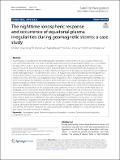| dc.description.abstract | Abstract
Recent studies revealed that the long-lasting daytime ionospheric enhancements of Total Electron Content (TEC) were sometimes observed in the Asian sector during the recovery phase of geomagnetic storms (e.g., Lei (J Geophys Res Space Phys 123: 3217–3232, 2018), Li (J Geophys Res Space Phys 125: e2020JA028238, 2020). However, they focused only on the dayside ionosphere, and no dedicated studies have been performed to investigate the nighttime ionospheric behavior during such kinds of storm recovery phases. In this study, we focused on two geomagnetic storms that happened on 7–8 September 2017 and 25–26 August 2018, which showed the prominent daytime TEC enhancements in the Asian sector during their recovery phases, to explore the nighttime large-scale ionospheric responses as well as the small-scale Equatorial Plasma Irregularities (EPIs). It is found that during the September 2017 storm recovery phase, the nighttime ionosphere in the American sector is largely depressed, which is similar to the daytime ionospheric response in the same longitude sector; while in the Asian sector, only a small TEC increase is observed at nighttime, which is much weaker than the prominent daytime TEC enhancement in this longitude sector. During the recovery phase of the August 2018 storm, a slight TEC increase is observed on the night side at all longitudes, which is also weaker than the prominent daytime TEC enhancement. For the small-scale EPIs, they are enhanced and extended to higher latitudes during the main phase of both storms. However, during the recovery phases of the first storm, the EPIs are largely enhanced and suppressed in the Asian and American sectors, respectively, while no prominent nighttime EPIs are observed during the second storm recovery phase. The clear north–south asymmetry of equatorial ionization anomaly crests during the second storm should be responsible for the suppression of EPIs during this storm. In addition, our results also suggest that the dusk side ionospheric response could be affected by the daytime ionospheric plasma density/TEC variations during the recovery phase of geomagnetic storms, which further modulates the vertical plasma drift and plasma gradient. As a result, the growth rate of post-sunset EPIs will be enhanced or inhibited. | en_US |
